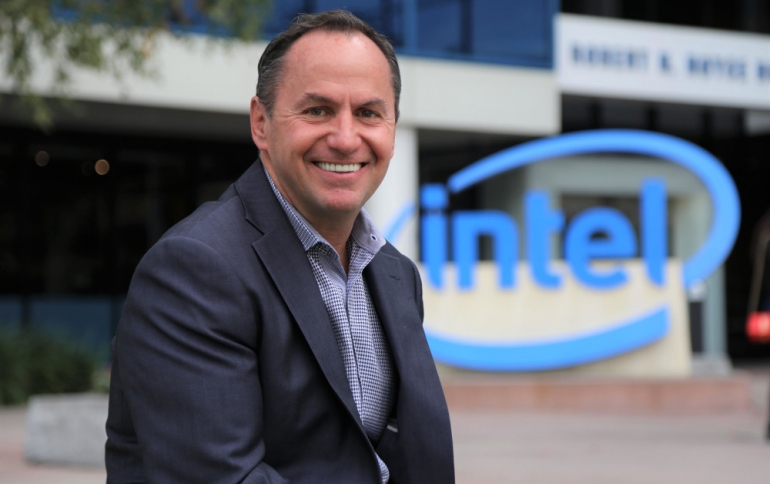
Intel CEO Outlines Company's Strategy
Intel CEO Bob Swan today issues a letter to stockholders, customers, partners, and employees, outlining the comapany's strategy, as part of the Intel's 2109 annual report.
He talked about the "emergence of data as a transformational force" for Intel and the fact that "nearly everything looks more like a computer and therefore what it means to have "Intel Inside" is changing."
Intel Inside goes well beyond the familiar CPU in the PC to include processors that orchestrate a network, visual processing units that help give a car awareness of its environment, and ASICs specially tuned to machine learning algorithms. Also, new, highly flexible packaging technologies enable platform solutions that solve challenges.
Swan said that Intel is positioned for another strong year in 2020. "We will continue to make significant investments in R&D and capital expenditures to deliver an unmatched portfolio of leadership products, increase capacity for our customers, and accelerate our Moore's Law transitions. We expect to return in excess of 100% of free cash flow in 2020 through our dividend and share repurchases. And finally, we will leverage our leadership position in the global tech ecosystem to help Intel and the industry make more progress in corporate responsibility, environmental sustainability, diversity, and inclusion," he said.
Intel is infusing Al into everything it builds. Cascade Lake is Intel's fastest ramping Intel Xeon processor ever and offers high Al performance, including built-in Intel Deep Learning Boost technology. Intel Movidius Vision Processing Unit is a performance leader for Al at the edge, and Intel recently acquired Habana Labs, further strengthening its broad Al portfolio.
Intel's co-founder Gordon Moore articulated a law of exponential improvement for semiconductors in 1965 that led us from tens, to tens of billions of transistors per chip.
To keep his vision alive, Intel is investing across six pillars of technology: process and packaging, architectures, memory, interconnects, security technologies, and software. At the same time, Intel Labs is researching completely new approaches to computing-such as neuromorphic, probabilistic, and quantum-that could unlock completely new opportunities.
Intel says that making the best semiconductors requires more than just the best manufacturing process technologies.With these six pillars, Intel is fosusing on xPU platforms able to serve diverse new workload opportunities (e.g., CPU, GPU, AI accelerator and FPGA).

In 2020, Swan promised that Intel "will continue to make progress with important new products, platform initiatives, and software optimizations."
Intel's data center performance will advance when our 3rd generation Intel Xeon Scalable processor debuts in the second quarter of 2020 with "Cooper Lake," followed by initial production shipments of 10-nanometer "Ice Lake" in the latter part of the year. Intel will also continue to deliver platform solutions in the data center, combining advancements in CPU with technologies like Intel Optane DC persistent memory.
Intel Xeon processors provide a foundation for analytics and AI, and software like the OpenVINO toolkit simplifies the deployment of solutions. Intel FPGAs allow Intel's customers to gain access to AI inferencing performance for their models. Similarly, the Intel Nervana Neural Network Processors and Intel Movidius Myria™ VPUs are purpose-built for AI and support diverse approaches for innovation in a wide range of applications, from healthcare to autonomous driving to facial recognition. Habana's Gaudi AI training Processor and Goya AI Inference Processor offer an easy-to-program development environment to help Intel's customers deploy and differentiate their solutions as AI workloads continue to evolve with growing demands on compute, memory, and connectivity.
Intel also continues to develop memory and storage solutions, including Intel QLC 3D NAND Technology and Intel Optane memory, to provide data center products that are optimized to performance and drive lower total cost of ownership for cloud workloads.
Intel's client performance in mobile has momentum to date on the strength of 10-nanometer Ice Lake system designs, and will advance with the company's newest Intel Core mobile processors, code-named "Tiger Lake," later this year. In addition, Swan said that Project Athena program helps the industry create laptops "with truly exciting innovations that consumers and businesses really care about, including longer battery life and instant wake features." Intel and its partners expect to have verified more than 70 Project Athena designs across Windows and Chrome by the end of this year.
Intel also launched the oneAPI industry initiative to deliver a unified and simplified programming model for application development across a global ecosystem on diverse architectures.
"Our pipeline of innovative 10-nanometer products is strong. We are accelerating the pace of process node introductions, moving back to a two- to two-and-a-half-year cadence with 7-nanometer-based products, and we are well down the engineering path on 5-nanometer," according to Swan.
2019 financial overview
Intel's transformation to a data-centric company continued in 2019, and the company experienced strong demand and reached product milestones.
The company achieved record revenue of $72.0 billion, 48% of which was from its data-centric businesses.
Intel invested $13.4 billion in R&D while reducing its spending to 27% of revenue. Additionally, Intel made capital investments of $16.2 billion, generated $33.1 billion cash from operations and $16.9 billion of free cash flow, and returned $5.6 billion in dividends to stockholders.
Acording to George Davis, Chief Financial Officer, Intel increased its wafer capacity during 2019; however, the company did not see a commensurate increase in client CPU unit volume as wafer capacity was largely consumed by increases in modem and chipset volumes, and unit die sizes.
5G continues to be a strategic priority, and Intel's exit from the 5G smartphone modem business is enabling the company "to increase the focus of our 5G efforts on the opportunity to modernize network and edge infrastructure," Intel's CFO aded.





















